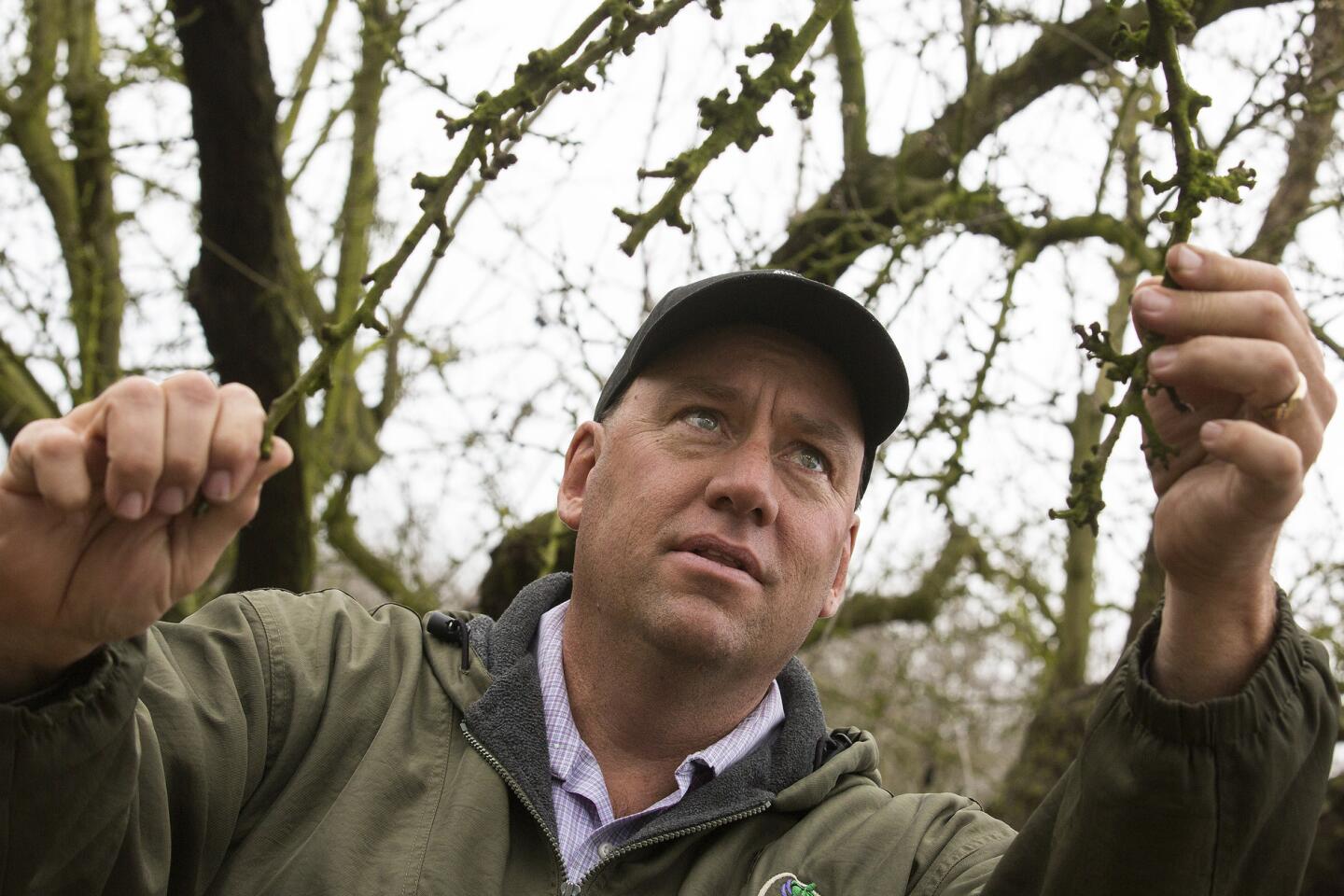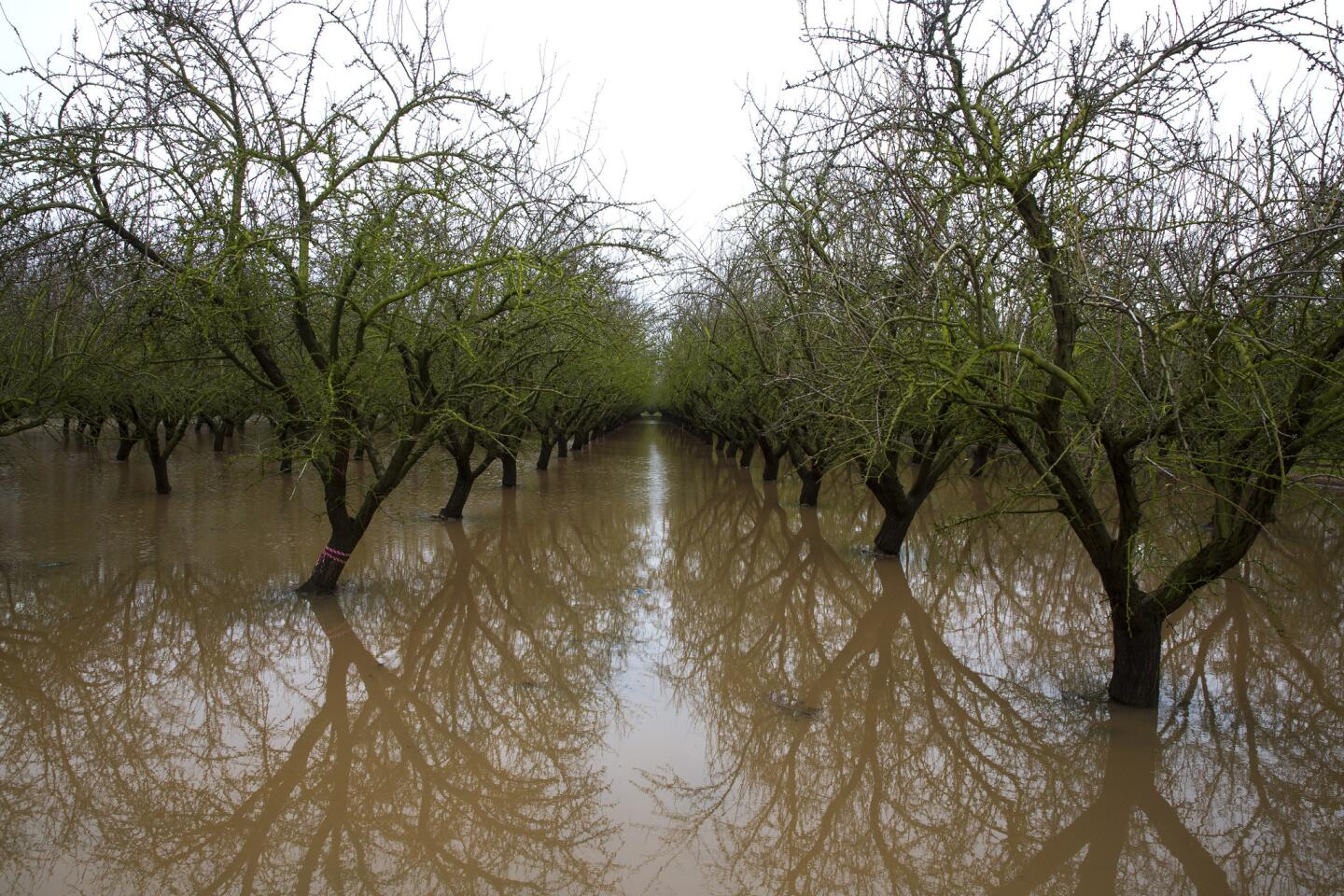Researchers test a possible drought solution by flooding an almond farm

- Share via
MODESTO — The El Niño rainstorm had already turned Nick Blom’s almond orchard into a quagmire. Still, he wheeled open the lid of a massive irrigation pipe. Fifteen minutes later, a gurgling belch heralded a gush of water that surged over the lip of the pipe and spread across five acres of almond trees.
Blom is neither crazy nor self-destructive. He’s a volunteer in an experiment run by UC Davis that could offer a partial solution to California’s perennial water shortages, and in the process, challenge some long-standing tenets of flood control and farming in the Central Valley.
The first notion that could be washed away is that the abundant rains spawned by the El Niño currents in the Pacific Ocean should be banked behind new or enlarged reservoirs. Instead, researchers believe they should pour that water onto fields and let it replenish groundwater overdrafted by farmers and cities during the state’s five-year drought.
Join the conversation on Facebook >>
That hypothesis, however, runs counter to how many growers care for their trees in winter, how irrigation districts operate, how water rights are managed, and how state and federal authorities have controlled floods for a century. Each will have to expand their notion of how to use water for the greater good so they can smooth out the state’s wild swings between drought and abundance, researchers say.
So they started small Tuesday — three, five-acre plots southwest of Modesto, on the 1,300 acres Blom farms with his father, Nick Sr. and brother, Pete.
“We can build more reservoirs and we can raise the dams of reservoirs, but that’s a very costly undertaking,” said UC Davis hydrologist Helen Dahlke. “Basically we’re trying to make use of the system that has been in place 40 or 50 years, when most farmers irrigated their fields using surface water, by just letting water run onto fields, and down a furrow.”
Gravity did most of the work Tuesday, as storm runoff flowed down irrigation canals and forced its way up and over the lip of Blom’s pipe. What Blom didn’t use will flow downstream to other farms and eventually back to the Tuolumne River, which joins the San Joaquin River nearby.
Hydrologists, plant scientists and others will monitor the fields to see how the water flows through the coarse soil below Blom’s feet, and what effect it will have on the trees and their roots. Water could spur more fungal diseases, for instance. But it also could drown out worms and mites that can damage crops, said Roger Duncan, agricultural extension director for Stanislaus County.
Researchers also will check to see if the flood water washes contaminants, such as the nitrogen from fertilizers and naturally occurring salts, into the groundwater. They’ll also compare yields on three fields treated different ways: leaving the trees’ fate to the weather, adding the normally small amount of winter irrigation, and pouring out several extra feet of water. Blom said he seldom irrigates over the winter, and gets about 2,200 pounds of almonds per acre.
It took months to orchestrate the conditions that merged on the Blom family ranch, and Tuesday’s downpour was not in those plans. Researchers cut back from the 8 inches they had planned to pour, to compensate for a couple of inches that had fallen since Sunday in a rare weather system that covered the Central Valley.
The three five-acre plots needed to have soils that allow water to percolate through quickly, and a grower willing to risk his trees. Blom had volunteered for other experiments. He also sits on the board of the Modesto Irrigation District, which owns its own reservoir (with a neighboring district) that holds more than 2 million acre-feet of water from the Tuolumne River.
Finding willing participants might be more difficult in other areas, where various federal and state agencies control the dams and canals of water projects that sprawl across dozens of irrigation districts and supply distant cities such as Los Angeles. Those districts and their grower members will be wary of watching their water disappear underground — and potentially flow where it will benefit someone else.
The Modesto Irrigation District delivers water to about 58,000 acres of farms, through a lattice of canals between the Tuolumne and Stanislaus rivers where they tumble toward the San Joaquin. Its coarse, alluvial soil absorbs water quickly, and most of it can be reached with wells of about 45 feet in depth, Blom said.
“It’s a benefit to everybody, because we do sit in a basin of water,” Blom said. “If we can put water into that basin throughout our area it’s going to help everybody’s groundwater. So, all the wells will be fine.”
That would include the city of Modesto, which uses both well water and surface supplies from the irrigation district.
Dahlke said about 3.6 million to 5 million acres of agricultural land would have suitable characteristics for similar recharge projects.
But she was well aware that such projects may not go smoothly in other districts that operate by strict rules about how and when they can release water. Often, agencies such as the Army Corps of Engineers release water in anticipation of storm events, not during them, Dahlke noted.
“If we know when they are making those releases, we can grab some of that water,” Dahlke said.
Dahlke said the concept will require a lot of cooperation, perhaps through incentives that will protect farmers and districts for using some of their allotted water on projects that provide a benefit beyond growing crops.
“I don’t think individual farm owners will be very successful in the future if they don’t start talking to their neighbors and start collaborating with other landowners,” she said. “Maybe it’s also time to look at the water rights system at some point, and figure out how we can modernize that system so it can accommodate practices like this one.”
Blom wasn’t thinking of that kind of politics Tuesday. He just hoped he hadn’t ruined a 17-year-old stand of almond trees.
“I’m very optimistic that I’ll be all right,” he said. “If it’s detrimental to the trees, I might lose five years out of the trees — I’ll get one good season of firewood.”
Twitter: @LATgeoffmohan
ALSO
2015 was the hottest year on record, according to new data
The situation is dire as Borrego Water District’s aquifer is being rapidly depleted
California to investigate whether Exxon Mobil lied about climate-change risks
More to Read
Inside the business of entertainment
The Wide Shot brings you news, analysis and insights on everything from streaming wars to production — and what it all means for the future.
You may occasionally receive promotional content from the Los Angeles Times.















